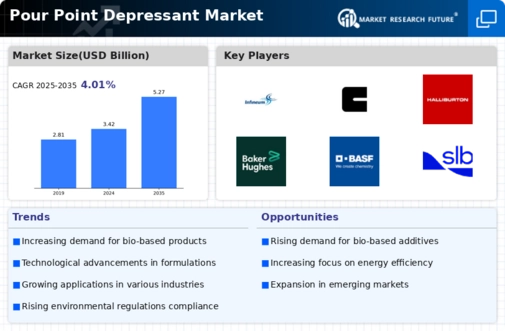Market Growth Projections
The Global Pour Point Depressant Market Industry is poised for substantial growth, with projections indicating a market size of 3.42 USD Billion in 2024 and an anticipated increase to 5.27 USD Billion by 2035. This growth trajectory reflects a compound annual growth rate of 4.02% from 2025 to 2035. The expansion is driven by various factors, including rising demand for low-temperature performance, technological advancements, and increasing production of crude oil and natural gas. The market's evolution is expected to be shaped by regulatory compliance and the growth of the automotive sector, indicating a dynamic landscape for pour point depressants.
Growth of the Automotive Sector
The expansion of the automotive sector significantly influences the Global Pour Point Depressant Market Industry. As vehicle production increases globally, the demand for high-performance lubricants that can withstand varying temperature conditions rises correspondingly. Pour point depressants are integral to formulating engine oils that ensure optimal performance and longevity, particularly in regions with extreme weather. The automotive industry's shift towards more efficient and environmentally friendly vehicles further drives the need for advanced lubricants. This growing demand is anticipated to contribute to the overall market growth, aligning with the projected increase in market size.
Rising Demand for Low-Temperature Performance
The Global Pour Point Depressant Market Industry experiences a notable increase in demand for products that enhance low-temperature performance in various applications. Industries such as automotive and oil and gas require lubricants that maintain fluidity at lower temperatures, thereby preventing operational issues. This trend is particularly pronounced in regions with harsh winter climates, where pour point depressants play a crucial role in ensuring the reliability of fuels and lubricants. As a result, the market is projected to reach 3.42 USD Billion in 2024, reflecting the growing emphasis on performance-enhancing additives in the formulation of lubricants.
Increasing Production of Crude Oil and Natural Gas
The Global Pour Point Depressant Market Industry is closely tied to the increasing production of crude oil and natural gas. As global energy demands rise, the extraction and transportation of these resources become more critical. Pour point depressants are essential in ensuring the smooth flow of crude oil and natural gas, particularly in colder climates where wax formation can impede production. The growing focus on maximizing output from existing fields and exploring new reserves is likely to bolster the demand for these additives. This trend supports the market's projected compound annual growth rate of 4.02% from 2025 to 2035.
Technological Advancements in Additive Formulation
Technological innovations in the formulation of pour point depressants significantly influence the Global Pour Point Depressant Market Industry. The development of new chemical compounds and blends enhances the effectiveness of these additives, allowing for improved performance in various applications. For instance, advancements in polymer chemistry have led to the creation of more efficient pour point depressants that require lower concentrations to achieve desired results. This not only reduces costs but also minimizes environmental impact. As the industry continues to evolve, these innovations are expected to drive market growth, contributing to an anticipated market size of 5.27 USD Billion by 2035.
Regulatory Compliance and Environmental Considerations
Regulatory frameworks governing the oil and gas industry increasingly emphasize environmental sustainability, impacting the Global Pour Point Depressant Market Industry. Manufacturers are compelled to develop pour point depressants that not only meet performance standards but also adhere to stringent environmental regulations. This shift towards eco-friendly additives is driven by the need to reduce the ecological footprint of petroleum products. Companies that invest in sustainable formulations are likely to gain a competitive edge, as consumers and regulatory bodies alike prioritize environmentally responsible products. This trend is expected to shape market dynamics in the coming years.







